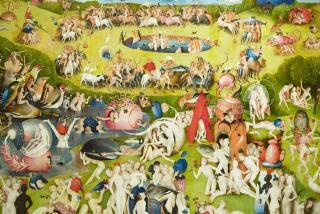House of Horrors : THE MUSEUM OF LOVE, <i> By Steve Weiner (The Overlook Press: $21.95; 214 pp.)</i>
In his fiction debut, Steve Weiner bypasses naturalism in favor of a hyperactive surrealism, by turns gruesome and lyrical, ecstatic and grotesque.
A picaresque noir tale of religious mania and obsessional quest, “The Museum of Love” presents in lieu of conventional story line a mosaic of hallucinatory fragments, with only the most tenuous grounding in everyday, familiar “reality.” The deranged young protagonist’s erratic journey across North America, although nominally taking place in the mid-’50s (there are fleeting references to Eisenhower’s presidency and the French defeat at Dien Bien Phu is actually filtered through a very contemporary consciousness, schooled in the labyrinth of deconstruction. Weiner’s prose techniques echo not only the delirious raw immediacy of the novels of Celine, Burroughs and Genet, but the cinematic disjunctions of Kronenberg and Lynch.
Lacking any true narrative structure, the book is loosely organized around a series of epiphanous, fetishistic exhibits or displays, significant stations in the hero’s strange pilgrimage of self-discovery: the so-called “museums” he comes across in his cross-country odyssey. Each “museum” showcases a theme: “Orphans,” “Love,” “Religion,” “Suicide,” “Death.” (Weiner’s “museum”-displays variously recall the Parisian 19th-Century closed arcades, with their revolving “panoramas,” which so fascinated culture-critic Walter Benjamin, and the haunting surrealistic box constructions of artist Joseph Cornell.)
In a run-down back street of Chicago, for instance, where in a late stage of his wanderings he winds up a derelict, Weiner’s protagonist/narrator visits “the museum of love,” a collection of phantasmagoric, diorama-like spectacles mounted in a former Christian Science church:
“In a six-foot-high diorama Indian women wild-riced. The moon was bright, silver crossed by flying silhouettes. Owls, badgers and muskrats peered from bracken. A moose foraged in shallows. A bigger moose with antlers mounted the first.
“In the second diorama a midnight hawk flew through the north woods. Below were a winding river, moonlit lakes, a tavern. I put a nickel in the slot. A chrome ball rolled down a forest road and dropped through a hole, came out below, rolled between miniature pine trees and dropped into a darker hole, which triggered a light in the tavern: plump and pink, a woman knelt on pillows.”
Obviously Weiner is not without expressive resources as a writer. He is especially adept at turning up the dark secrets hidden in the somber Upper Great Lakes landscape, which provides the setting of his early chapters. In these he demonstrates a gift for evoking place and mood in lurid, surreal tones, dusting the rough substantives of his tale with macabre lights and hues. The atmosphere of dream and distortion thus created is enhanced by the novel’s brisk, staccato pacing, as Weiner moves his narrative forward with an unsettling stop-and-go progress. That jerky pace mimes the disturbed--and disturbing--disjunctive mental processes of his protagonist, a French Canadian youth.
Jean-Michel is a young fellow with more than his share of problems. He is haunted by terrible hallucinations, morbid dreams of corruption and decay. And little wonder, for he suffers multiple impediments, from a speech defect and a stunted leg to a particularly horrifying family life. Indeed, the repulsive tale of serial necrophilia with which the novel opens (and which sets its tone)--a homicidal farmer “disassembles” and grotesquely reconstructs the exhumed bodies of women--is told by Jean-Michel’s father, a crude, brutish and oppressive Canuck prison guard from whom our hero spends much of the book on the run.
“Ed Gien had dug up women from the Lutheran cemetery, brushed them with resin and beeswax, and dressed them in his dead mother’s shawls. He made ashtrays of their joints and lampshades and upholstery of their skin. Vises held rotted women’s limbs in steel ball-and-socket armatures. Hip, breast, hair and thigh twirled over our heads from black fishing wire.
“ ‘Woman,’ my father whistled. ‘Disassembled.’ ”
To get through “The Museum of Love” one will need a strong stomach, not only to digest the recurrent, vivid and graphic shock-imagery of bodily function and disfunction, mutilation, flesh-pulverization and flying blood and guts, but to handle the novel’s heavy-duty philosophical and psychological menu. There is much heady riffing on themes of anti-Colonialism and sexual ambiguity, a major dollop of Catholic guilt-complex served up in the form of the narrator’s relentless fixation on physical degeneration, and above all a hyper-insistent preoccupation with the topic of deconstruction. More dismembered bodies, chopped, diced and splattered, litter the random trail of Jean-Michel’s travels than Jeffrey Dahmer could shake a fork at.
“Our lives are incoherent,” Jean-Michel’s father declares on his death bed. That’s certainly the singular message this promising but problematic novel projects. For all its energy, “The Museum of Love” is cheerless. Then again, perhaps, in the cafe nihilism ambience of the mid-’90s, a bland acceptance of the senselessness of existence has become aesthetically de rigeur. Have we Twin-Peaked ourselves into a frazzle of hallucinated ennui, our tolerance of the insanity of postmodern life so total as to render incoherence chic?
More to Read
Sign up for our Book Club newsletter
Get the latest news, events and more from the Los Angeles Times Book Club, and help us get L.A. reading and talking.
You may occasionally receive promotional content from the Los Angeles Times.






